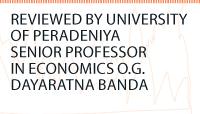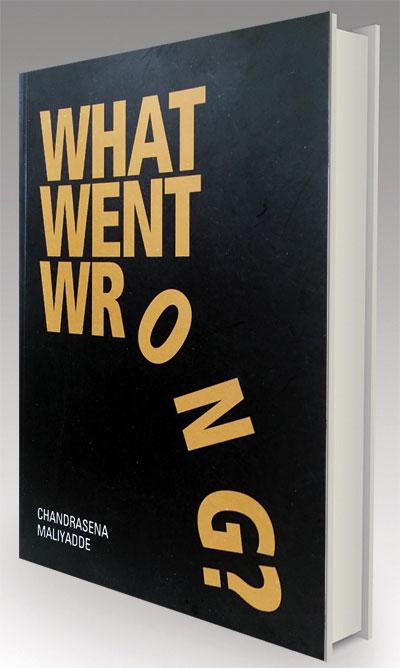03 May 2023 - {{hitsCtrl.values.hits}}
 Sri Lanka is facing the worst economic crisis of unprecedented magnitudes while the world seems to be lurching from one crisis to another as we have experienced a global pandemic, economic crises, dramatic changes to how we conduct our daily lives, economic uncertainty and political and social turmoil, exploding the bipolar world order with the rise of Asia and Africa as well as an array of natural disasters.
Sri Lanka is facing the worst economic crisis of unprecedented magnitudes while the world seems to be lurching from one crisis to another as we have experienced a global pandemic, economic crises, dramatic changes to how we conduct our daily lives, economic uncertainty and political and social turmoil, exploding the bipolar world order with the rise of Asia and Africa as well as an array of natural disasters.
In this backdrop, drawing on his vast experience, Chandrasena Maliyadde, an economics graduate of the University of Peradeniya and a renowned public servant, with an illustrious career at the highest levels of policymaking and planning in Sri Lanka, in his book ‘What Went Wrong?’, provides policymakers, students and the public with innumerable insight into decades of economic and social development in Sri Lanka in the context of public policy and policy politics.
This analytical masterpiece, written in the ‘op-ed’ style along the lines of memoirs, which is a collection of analytical public policy and development review articles published in print media for more than a decade, addressing the most prominent contemporary issues and challenges, has unveiled many myths, fallacies, trials and tribulations and missed opportunities of decades of development efforts in the country. Tracing the spectacular trajectory of Maliyadde’s life from its humble beginning in the suburban Mahanuwara to the chambers of power in Colombo, this book is a significant masterpiece of insider account with a rigorous critique and analysis of how Sri Lanka’s development story gradually transformed into a tragic tale, due to policy blunders, miscarriages, policy missteps in a country with a highly ignorant population. The economic catastrophe has, indeed, been an inevitable outcome, given that people, whether educated or uneducated, ignorant and lost as they are, have been living in the historical wilderness armed with wishful thinking and looking only backwards toward history and heritage, hoping that either an economic miracle might happen or somebody else will do everything to automatically take them into economic and social bliss point of highest affluence, while many things that happened or have been done, in the economy at the macro as well as micro levels, contributed little to significant economic progress.
 The book traverses the economic development trajectory, politics, policymaking, personalities, events and crises of multiple nature in Sri Lanka’s recent history in a number of topics, including overall achievements of economic development, issues and challenges of the agricultural sector, the perils of investment promotion efforts, the role of the Central Bank and the workings and mechanisations of the monetary policy, debt and aid-led development, issues of and misgivings about governance and politics, health sector perils, education and manpower development drawbacks, lopsided efforts for infrastructure development, ill-prioritised industrialisation efforts and the lethargic public service. It goes behind numbers, case studies and various sparklingly strong narratives to bring alive the politics of policy and reforms and how development efforts contributed little to development while taking the country towards the current catastrophe.
The book traverses the economic development trajectory, politics, policymaking, personalities, events and crises of multiple nature in Sri Lanka’s recent history in a number of topics, including overall achievements of economic development, issues and challenges of the agricultural sector, the perils of investment promotion efforts, the role of the Central Bank and the workings and mechanisations of the monetary policy, debt and aid-led development, issues of and misgivings about governance and politics, health sector perils, education and manpower development drawbacks, lopsided efforts for infrastructure development, ill-prioritised industrialisation efforts and the lethargic public service. It goes behind numbers, case studies and various sparklingly strong narratives to bring alive the politics of policy and reforms and how development efforts contributed little to development while taking the country towards the current catastrophe.
The book captures diverse aspects of agriculture, covering how state machinery contributed a little to the agricultural sector’s progress, the issues pertaining to the implementation of organic farming in a haphazard and disastrous manner and a lack of diversification, innovation and growth of key agricultural sub-sectors. The author discusses and concludes that the sudden switchover, in an unwise and ill-informed manner, to complete organic farming never worked and decades of agricultural development efforts, in general, have generated inadequate positive results. His analysis of trade policy and industrialisation strategy sheds some important insight in which he claims that export promotion and import substitution are not mutually exclusive but complementary, also highlighting the fact that the failure to adopt a correct trade policy and industrialisation strategy has resulted in Sri Lanka being a dumping ground of cheap and low-quality foreign products. While the merits of this position are well recognised, it is also the case that any industrialisation effort needs to encompass well-thought-out policy efforts to promote import-competing industries through reverse engineering, following science and technology as well as scientific innovations. Sri Lanka’s industries, in general, have failed to transform through time to achieve international competitiveness as trade protectionism has been a shield to survive in the infant industry set-up. This implies that Sri Lanka needs a new industrialisation strategy that addresses both export promotion and domestic demand-led growth.
The author also extensively discusses numerous issues pertaining to investment promotion in Sri Lanka and goes on to conclude that the investment promotion efforts of state institutions have failed to establish an effective ‘one-stop shop’ for many decades, which is why many quip that it is not a one-stop shop of investment facilitation and promotion in the case of Sri Lanka and that it is a ‘one-stop-stopped shop’ of investment promotion. My Maliyadde’s take on central banking and monetary policy goes along the lines of Keynesian doctrine, giving a significant role to fiscal interventions financed through foreign aid in which the author makes a claim that aid has contributed to economic development in a significant way, though the foreign debt has become more of a problem than a solution to shortages of development finances.
Maliyadde’s take on the progress and performance of the health sector is mixed, while the free education system, an enterprise much admired by many, though has created an educated class, has prevented the ‘right to education of many’, especially as the higher education sector has failed to reform to reap its full potential to widen the educational opportunities and to positively contribute to national development and there are doubts whether skill development component has been addressed properly and adequately. In the book, the author also analyses many aspects of public unities and infrastructure development efforts, giving credit to certain achievements while uncovering many impediments and policy controversies.
His analysis of public service, as an insider, is fascinating, as he has discussed numerous issues and challenges with first-hand information and the dire need to reform it. He goes on to conclude that the present need is for a dynamic, skilful, effective professional public service rather than an independent public service. The author also discusses the merits and demerits of the executive presidency and what it has become about with time, creating more problems for good governance and effective development administration. Drawing parallels to the ancient episode of Yasalalakathissa tragedy, the author queries whether the so-called ‘Yahapalanaya’ actually became a ‘Subha/Yasa Palanaya’, highlighting the melodramas unfolded in Sri Lanka in recent years, which put so much fuel to the already engulfing fire of socioeconomic distress in Sri Lanka.
In summary, the book covers a large number of topics, highlights numerous issues and policy controversies, discusses the challenges for development and advocates numerous policy measures to put everything in the right order to make Sri Lanka ‘one of the miracles of Asia’. Though politicians and many others wished for decades that Sri Lanka will become a ‘Wonder of Asia’, the country seems to have become a ‘Blunder of Asia’, which is a development story that gives ample opportunities for students in economic development and political economy to learn how not to run a country and how it is humanly possible for perpetual bad governments with a misplaced citizenry to take a country along the path of disaster.
The book enlightens us all about how we got to where we are today, due to the two steps forward and three steps backward approach to economic development that is characterised by policy blunders, offering an insightful, eloquent and academically sound analysis, irrespective of the fact that everybody will not agree with the ideological positions within which the arguments are presented and conclusions are drawn.
The book also goes on to conclude in general that Sri Lankans are only good at wishful thinking and living in the past criticising and writing post-mortems once something has happened and they lack the ability to forecast, anticipate, predict or foresee what would be the path that the economy or society takes, given the current situation and what happened in the past and redirect or correct or take remedial actions to reorient the development path if the country is treading in a wrong path. The book is placed well within the domain of political economy of development, offering a useful reading for students of economics and politics as well as it is a must-read piece for seasoned policymakers and budding public servants.
The book also unveils a large number of researchable questions and controversies, which will attract the attention of postgraduate students and researchers seeking to advance our understanding of development in complex policy contexts. Narrated with wit, humour and impeccable intellect, ‘What Went Wrong?’ is a seminal contribution to development policy analysis and practice in Sri Lanka by one uniquely positioned to write it. Nobody in the policymaking circles should miss, indeed, reading this classic piece of work by Maliyadde as one of the renowned highest-level policymakers, who has used his decades of accumulated practical knowledge, experience and skills. As Palihakkara, a former Foreign Secretary of Sri Lanka, has succinctly penned in his introduction to the book, this work will certainly help illuminate policymakers to make better choices in executing public policymaking in the country.
01 Nov 2024 30 minute ago
01 Nov 2024 45 minute ago
01 Nov 2024 55 minute ago
01 Nov 2024 2 hours ago
01 Nov 2024 3 hours ago